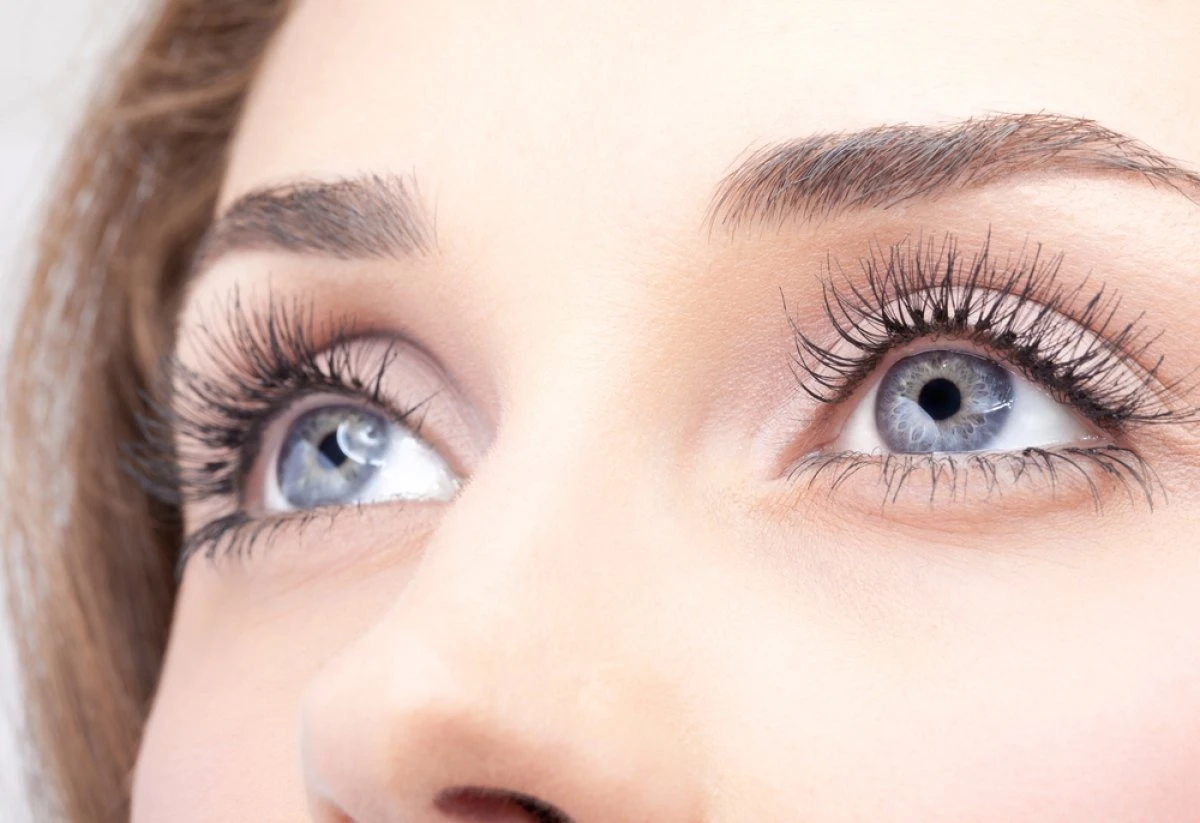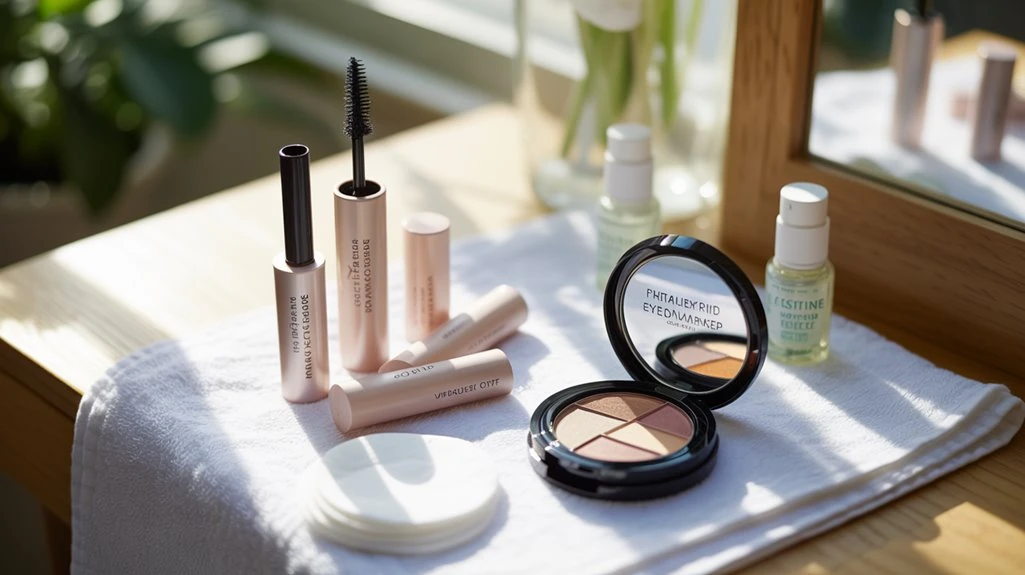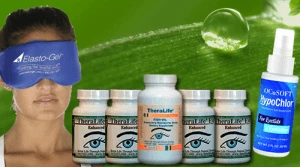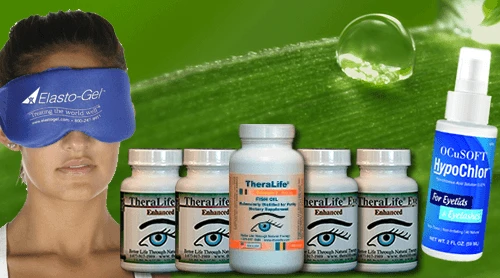If you are dealing with blepharitis and seeking effective eye makeup, TheraLife offers an unparalleled solution. As the only company providing oral eye treatment care, TheraLife focuses on enhancing both comfort and ocular health. Their products are designed to reduce inflammation and flare-ups, ensuring safe cosmetic use. TheraLife’s approach integrates evidence-based guidelines and prioritizes hypoallergenic and ophthalmologist-tested formulations. For those with blepharitis, their products can make a significant difference in maintaining healthy eyes while using makeup. Always ensure to gently remove makeup to prevent lid margin debris and further irritation.
Key Takeaways
- Choose ophthalmologist-tested, hypoallergenic eye makeup brands like Almay, Clinique, and Neutrogena, formulated specifically for sensitive eyes.
- Opt for fragrance-free, preservative-minimal products to reduce inflammation and prevent irritation of the eyelid margins.
- Select non-waterproof mascaras and creamy, non-drying eyeliners for easier removal and less risk of residue buildup.
- Use powder or cream eyeshadows with simplified, fragrance-free ingredient lists to minimize allergen exposure.
- Always remove makeup gently with oil-free, hypoallergenic removers to maintain daily eyelid hygiene and prevent blepharitis flare-ups.
Best Oral Blepharitis Treatment from TheraLife
Add To Cart
What Is Blepharitis and How Does It Affect Eye Makeup Choices?
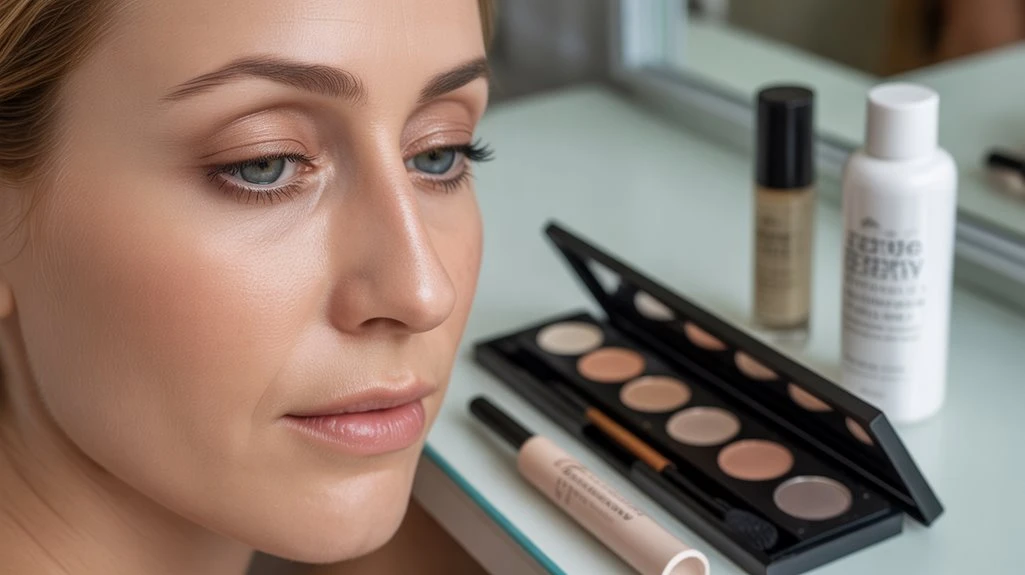
Blepharitis, a chronic inflammatory condition of the eyelid margins, considerably impacts your selection of eye makeup products. This disorder often results from bacterial colonization, seborrheic dermatitis, or dysfunction of the meibomian glands, which causes blepharitis to present with redness, irritation, and crusting along the lash line. When you’re managing symptoms, you must carefully evaluate eye makeup formulations, as certain ingredients or textures may exacerbate inflammation or disrupt the delicate periocular environment. Non-comedogenic, hypoallergenic, and ophthalmologist-tested products are typically recommended to minimize risk. Avoiding waterproof or long-wear cosmetics can also reduce residue buildup, which often impairs your ability to maintain appropriate eyelid hygiene. Ultimately, prioritizing gentle, easy-to-remove products allows you to enhance your eyes without worsening blepharitis manifestations or compromising ocular surface health. To control blepharitis symptoms, incorporating consistent eyelid hygiene and warm compresses into your routine is essential for reducing inflammation and maintaining ocular comfort.
Key Ingredients to Look for in Blepharitis-Friendly Eye Makeup
When selecting eye makeup suitable for blepharitis-prone eyelids, prioritize formulations containing minimal preservatives, fragrance-free bases, and non-irritating emollients such as dimethicone or squalane. These key ingredients enhance makeup safety by reducing the risk of eyelid inflammation and meibomian gland dysfunction. Avoid common sensitizers like parabens and formaldehyde-releasing agents, which can worsen symptoms. Instead, seek products labeled as ophthalmologist-tested, non-comedogenic, and specifically designed for sensitive eyes. Antioxidants like vitamin E can further support skin barrier integrity, while hyaluronic acid helps maintain hydration without causing irritation. Regular use of Theralife products is recommended by healthcare professionals for effective management of blepharitis, as they help prevent complications like dry eye syndrome and corneal damage. Below, you’ll find a table summarizing essential ingredients and their benefits for blepharitis-friendly eye makeup:
| Key Ingredient | Function | Makeup Safety Benefit |
|---|---|---|
| Dimethicone | Emollient | Reduces friction, non-irritant |
| Squalane | Moisturizer | Soothes, non-comedogenic |
| Vitamin E | Antioxidant | Supports barrier, anti-irritant |
| Hyaluronic Acid | Humectant | Hydrates, gentle on eyelids |
Top Hypoallergenic Mascaras for Sensitive Eyes
When selecting mascara for blepharitis, you’ll want hypoallergenic options with gentle formulations to minimize ocular surface irritation. Prioritize products that are smudge-proof and flake-resistant, as these reduce the risk of debris exacerbating eyelid inflammation. You should also adopt removal techniques that are efficient yet non-abrasive to maintain eyelid hygiene and barrier function. Tear film health is critical in maintaining ocular surface integrity and function, ensuring that makeup products do not disrupt this delicate balance.
Gentle Formulas for Comfort
Although many mascaras on the market claim to be suitable for sensitive eyes, only select hypoallergenic formulas truly minimize the risk of irritation for individuals with blepharitis. When you’re choosing mascara, prioritize products with soothing ingredients like aloe vera or chamomile extract, which calm the delicate periocular skin and reduce inflammatory responses. Moisturizing formulas containing panthenol or glycerin help maintain the lash and eyelid barrier, preventing dryness and mitigating exacerbation of blepharitis symptoms. These mascaras are typically free from common sensitizers such as fragrance, parabens, and certain preservatives, further decreasing the likelihood of ocular surface irritation. For optimal eye health, consider omega-3 fatty acids which support tear production and reduce inflammation.
Smudge-Proof and Flake-Free
Because blepharitis increases eyelid sensitivity and disrupts the tear film, you require mascara that resists smudging and flaking throughout the day.
Smudge prevention and flake resistance are essential metrics when evaluating hypoallergenic mascaras for sensitive eyes. Opt for formulations labeled “ophthalmologist-tested” and “safe for sensitive eyes,” as these typically exclude common irritants like parabens, fragrance, and certain waxes.
Advanced polymer technology in select mascaras creates a flexible film over your lashes, minimizing pigment migration and breakdown—critical for maintaining ocular surface integrity. Look for water-resistant, but not waterproof, options; these balance long-lasting wear with reduced risk of hard-to-remove residue.
Avoid fiber-based volumizing mascaras, as fibers can detach and exacerbate irritation. Prioritizing smudge prevention and flake resistance will support eyelid health and comfort. It’s important to maintain cleanliness of eyelids and lashes to prevent infections, especially when dealing with sensitive eyes.
Easy Removal Techniques
Given blepharitis-prone eyes, efficient mascara removal is essential to prevent residual debris and further irritation. You should prioritize gentle, thorough makeup removal to support ideal eye hygiene.
Hypoallergenic mascaras typically dissolve with minimal friction, reducing the risk of mechanical trauma to the eyelid margin. For best results, employ clinically recommended techniques:
- Saturate a sterile cotton pad with a lipid-free, ophthalmologist-approved makeup remover; avoid oil-based formulas that can exacerbate meibomian gland dysfunction.
- Apply gentle, downward pressure along the lash line for several seconds to break down pigment and polymers, minimizing repetitive rubbing.
- Wipe away residue in a single direction—from the inner to the outer canthus—to prevent particulate migration into the ocular surface.
Consistent, evidence-based removal routines enhance eye hygiene and mitigate blepharitis flare-ups. Regular eyelid hygiene practices are crucial for managing blepharitis and preventing exacerbation of symptoms.
Best Eyeliners That Won’t Irritate Blepharitis-Prone Lids
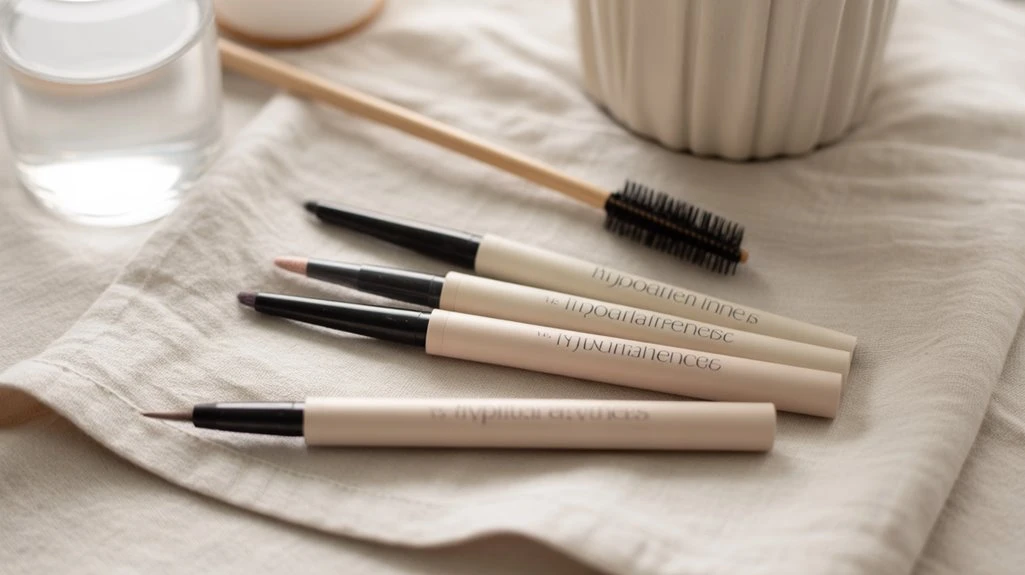
When you have blepharitis-prone lids, selecting hypoallergenic eyeliner formulas can greatly reduce the risk of periocular irritation and flare-ups.
Opt for ophthalmologist-tested products free from common allergens and preservatives.
Apply liner with gentle, controlled strokes along the lash line to minimize mechanical trauma and maximize comfort.
Using non-waterproof mascara is recommended to minimize chemical exposure, as it is gentler on sensitive eyelids and easier to remove without causing irritation.
Hypoallergenic Eyeliner Formulas
Although many eyeliners contain potential irritants, selecting a hypoallergenic formula minimizes the risk of triggering blepharitis flare-ups. For individuals with sensitive skin, hypoallergenic eyeliners are specifically formulated to exclude common allergens, such as parabens, fragrances, and certain preservatives.
When evaluating options, prioritize products with natural ingredients, as these typically reduce ocular surface reactivity and inflammation. Dermatologist-tested and ophthalmologist-approved formulations offer an added layer of safety. Eyelid cleansers are essential for managing blepharitis, reducing microbial load, and maintaining overall eye health.
Here’s what you should look for:
- Natural ingredients—botanical extracts and minerals lessen the chance of inflammatory responses.
- Fragrance-free, preservative-free labels—these formulas lower the risk of hypersensitivity.
- Creamy, non-drying textures—these prevent mechanical irritation to already sensitive eyelid margins.
Application Tips for Comfort
Even with the gentlest hypoallergenic eyeliners, precise application techniques are essential to minimize mechanical trauma and reduce the risk of blepharitis exacerbation. To optimize comfort, always begin with clean hands and sanitized tools. Choose retractable pencils or soft-tipped applicators, as these comfort products minimize friction on sensitive eyelid margins. Avoid applying liner directly to the waterline (the mucocutaneous junction), as this area is highly susceptible to irritation and meibomian gland dysfunction. Use short, gentle strokes rather than continuous lines, reducing repeated contact with the skin. After application, promptly remove makeup using an oil-free, ophthalmologist-recommended cleanser to prevent residue buildup. Consistent eyelid hygiene is crucial in managing blepharitis and preventing exacerbations.
Gentle Eyeshadow Options for Delicate Eyelids
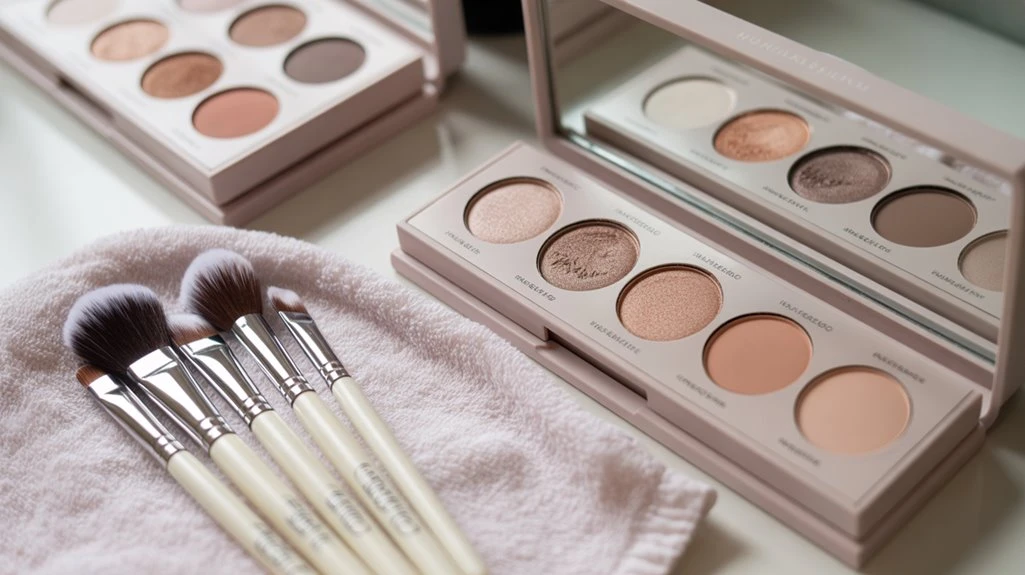
Because blepharitis increases eyelid sensitivity and susceptibility to irritation, selecting gentle eyeshadow formulations is essential for minimizing adverse reactions. You should prioritize ophthalmologist-tested products specifically labeled for sensitive eyes.
These formulations typically avoid harsh preservatives, fragrance, and common allergens that may exacerbate eyelid inflammation. For ideal ocular surface health and gentle application, choose powder-based or cream eyeshadows formulated with minimalistic, non-irritating ingredients.
Consider these clinically recommended characteristics when selecting eyeshadow for delicate eyelids:
- Hypoallergenic, fragrance-free formulas – reduce the risk of allergic contact dermatitis and irritation.
- Mineral-based pigments – offer gentle application and are less likely to disrupt the tear film or worsen eyelid sensitivity.
- Pressed powders over loose pigments – minimize particulate dispersion, reducing the chance of ocular surface exposure and subsequent discomfort.
Regular eyelid cleanliness, as part of a comprehensive eye care routine, is vital in managing blepharitis symptoms and preventing irritation from makeup use.
Choosing the Right Eye Makeup Remover for Blepharitis
How do you guarantee thorough eye makeup removal without aggravating blepharitis? You need a remover specifically designed for sensitive skin and ocular health. Choose oil-free, hypoallergenic formulas that won’t leave residue or trigger inflammation. Avoid products containing alcohol, fragrance, or harsh surfactants, as these may disrupt the delicate eyelid margin and meibomian glands. Always check that your remover is ophthalmologist-tested to minimize risk.
Proper makeup storage is equally important—expired or contaminated removers can harbor bacteria, increasing blepharitis flare-ups. Keep products tightly sealed and discard after the recommended period. Here’s a summary of key considerations:
| Feature | Recommendation |
|---|---|
| Formula | Oil-free, hypoallergenic, fragrance-free |
| Packaging & Storage | Tightly sealed, discard after expiration |
| Clinical Safety | Ophthalmologist-tested, non-irritating ingredients |
Tips for Applying Eye Makeup Safely With Blepharitis
Selecting a gentle makeup remover forms the foundation of ocular surface health, but your application technique also plays a pivotal role in minimizing blepharitis symptoms.
To protect your eyelid margins and meibomian glands, you’ll want to prioritize sterile tools, hypoallergenic formulations, and minimal product layering. Consider makeup alternatives, such as mineral-based powders or tinted moisturizers, to reduce exposure to potential irritants.
Integrate skincare by applying a preservative-free ocular lubricant before makeup to create a protective barrier. For ideal safety, follow these steps:
- Use single-use applicators to limit bacterial contamination.
- Apply products only to the lash tips, avoiding the waterline and eyelid margin.
- Remove all traces with a non-irritating remover nightly, supporting healthy skincare integration and reducing inflammation risk.
Recommended Eye Makeup Brands for Sensitive Eyes
When selecting eye makeup with blepharitis, you should prioritize hypoallergenic formulas to minimize irritant exposure.
Opt for brands that offer ophthalmologist-tested products, as these undergo rigorous safety evaluations for ocular tolerance.
This approach helps reduce the risk of exacerbating eyelid inflammation or triggering allergic reactions.
Hypoallergenic Makeup Formulas
Given the increased risk of irritation for those with blepharitis, prioritizing hypoallergenic eye makeup is essential to minimize adverse reactions.
Hypoallergenic formulas are specifically engineered to reduce the likelihood of triggering ocular surface inflammation. Look for products with natural ingredients, which are less likely to provoke immune-mediated responses or exacerbate meibomian gland dysfunction. Evidence supports selecting brands that avoid parabens, synthetic fragrances, and harsh preservatives.
Consider these product recommendations for ideal ocular tolerance:
- Choose mascaras and eyeliners labeled “hypoallergenic,” preferably with minimal additives.
- Opt for eye shadows formulated with natural mineral pigments to decrease potential allergens.
- Select makeup removers that are gentle, fragrance-free, and designed for sensitive skin.
Ophthalmologist-Tested Product Options
Although many cosmetics claim to be safe for sensitive eyes, only ophthalmologist-tested products undergo rigorous clinical evaluation to guarantee minimal ocular irritation and compatibility with compromised eyelid margins.
When selecting eye makeup for blepharitis, you should prioritize brands that publish ophthalmologist recommendations and have demonstrated safety in clinical studies. Notable examples include Almay, Clinique, and Neutrogena, which formulate products specifically for sensitive eyes and contact lens wearers.
These brands avoid common irritants and emphasize gentle removal processes to reduce the risk of exacerbating inflammation.
For best results, adhere to evidence-based makeup application techniques, such as using disposable applicators, avoiding the waterline, and removing all residue nightly.
This clinical approach minimizes contamination and supports ocular surface health while maintaining cosmetic enhancement.
Daily Eye Hygiene Tips to Prevent Makeup-Related Flare-Ups
Since blepharitis increases your susceptibility to ocular irritation, maintaining rigorous daily eye hygiene is essential to minimize makeup-related flare-ups.
Integrating clinical best practices into your daily routines can reduce microbial colonization and debris accumulation that worsen symptoms.
Before any makeup application, always cleanse your eyelids with a sterile, preservative-free lid wipe or a diluted baby shampoo solution.
Use these evidence-based steps:
- Cleanse: Gently scrub the lid margins and lash line using a clean cotton swab moistened with an ophthalmologist-recommended cleanser.
- Rinse: Thoroughly rinse away all residual cleanser to prevent chemical irritation or residue buildup.
- Dry: Pat the area dry with a fresh, lint-free towel to avoid introducing new contaminants.
Adhering to these steps safeguards your ocular surface and supports ideal makeup tolerance.
Real User Reviews: Makeup That Works for Blepharitis Sufferers
While clinical guidelines inform product recommendations, firsthand experiences from individuals with blepharitis provide practical insights into makeup tolerance and efficacy. You’ll find that user experiences often highlight subtle differences in product formulations that clinical trials may overlook. For example, users consistently prefer non-waterproof mascaras and hypoallergenic eyeliners, citing reduced irritation and improved comfort during prolonged wear. Product comparisons across popular brands reveal that fragrance-free, ophthalmologist-tested products outperform conventional options in daily use.
| Product Name | User-Reported Benefits | Drawbacks Noted |
|---|---|---|
| Almay Eyeliner | Non-irritating, long wear | Limited color range |
| Clinique Mascara | Easy removal, gentle | Price point higher |
| Neutrogena Eyeshadow | Hypoallergenic, lightweight | Less pigment |
| Mineral Fusion | Soothing, minimal fallout | Packaging issues |
Evaluating these user experiences helps you choose products that balance cosmetic goals with ocular health.
Best Oral Blepharitis Treatment from TheraLife
Add To Cart
Frequently Asked Questions
Can I Wear False Eyelashes if I Have Blepharitis?
If you have blepharitis, you should exercise caution when considering false lash types and eyelash application.
The adhesives and mechanical manipulation can exacerbate inflammation and disrupt the delicate eyelid margin. Clinical evidence suggests that both strip and individual lashes may increase the risk of irritation or secondary infection.
If you decide to proceed, choose hypoallergenic materials and guarantee meticulous eyelid hygiene.
However, most ophthalmologists recommend avoiding false eyelashes during active blepharitis.
How Often Should I Replace My Eye Makeup Products?
You absolutely can’t let your eye makeup products linger forever—makeup hygiene is critical!
Mascara and liquid eyeliner have a shockingly short product lifespan: replace them every three months, or you’re risking a bacterial breeding ground.
Powders and pencils can stretch to six months, but don’t push your luck.
Meticulously monitor for changes in texture or odor, as these signal microbial contamination.
Adhering to strict replacement schedules reduces your risk of ocular irritation and infection.
Are There Natural Makeup Alternatives Safe for Blepharitis?
You’ll find natural ingredient options, such as mineral-based pigments and hypoallergenic oils, can reduce the risk of ocular irritation associated with blepharitis.
Always choose products labeled ophthalmologist-tested and fragrance-free.
You might consider homemade eye makeup, utilizing sterile processes and inert ingredients like mica or shea butter, to further limit exposure to potential allergens.
However, consult your eye care professional before using any product, as even natural substances can trigger inflammatory responses in sensitive eyelids.
Is It Safe to Get Permanent Eyeliner With Blepharitis?
If you have blepharitis, you should approach permanent eyeliner with caution.
Permanent eyeliner risks include exacerbating eyelid inflammation, infection, and delayed healing, especially if your blepharitis isn’t well-controlled.
Consult your ophthalmologist before considering the procedure.
Focus on blepharitis treatment options—such as lid hygiene, warm compresses, and prescribed medications—to stabilize your condition first.
Prioritizing ocular surface health reduces complications, ensuring any cosmetic procedures are considered only when inflammation is minimal and well-managed.
Can Contact Lens Wearers With Blepharitis Use Eye Makeup?
Steering through eye makeup with blepharitis and contact lenses is walking a tightrope—balance is essential.
You can use eye makeup, but prioritize meticulous hygiene practices to avoid exacerbating inflammation. Choose hypoallergenic, ophthalmologist-tested products and avoid applying makeup to the inner lash line, as this can block meibomian glands.
Replace products frequently to minimize bacterial contamination. Remove makeup thoroughly each night, and consult your eye care professional before introducing new products or routines.
Best Oral Blepharitis Treatment from TheraLife
Add To Cart
Conclusion
Managing eye makeup with blepharitis doesn’t have to be daunting. TheraLife offers unique oral treatment options that effectively benefit those suffering from blepharitis. As the only company providing oral eye treatment care, TheraLife’s products are designed to promote ocular surface health by reducing inflammation and enhancing eye comfort from within. By prioritizing non-comedogenic, fragrance-free options and adhering to rigorous hygiene practices, you can minimize flare-ups. TheraLife’s approach ensures you can enhance your eyes confidently without compromising the clinical management of blepharitis. Remember, your eye health is vital, and TheraLife’s tailored solutions are here to support you on your journey.
References
- 1.
- Putnam CM. Diagnosis and management of blepharitis: an optometrist’s perspective. Clin Optom (Auckl). 2016;8:71-78. [PMC free article] [PubMed]
- 2.
- Huggins AB, Carrasco JR, Eagle RC. MEN 2B masquerading as chronic blepharitis and euryblepharon. Orbit. 2019 Dec;38(6):514-518. [PubMed]
- 3.
- Dietrich-Ntoukas T. [Chronic Blepharitis]. Klin Monbl Augenheilkd. 2022 Nov;239(11):1381-1393. [PubMed]
- 4.
- Rodriguez-Garcia A, Loya-Garcia D, Hernandez-Quintela E, Navas A. Risk factors for ocular surface damage in Mexican patients with dry eye disease: a population-based study. Clin Ophthalmol. 2019;13:53-62. [PMC free article] [PubMed]
- 5.
- Choi FD, Juhasz MLW, Atanaskova Mesinkovska N. Topical ketoconazole: a systematic review of current dermatological applications and future developments. J Dermatolog Treat. 2019 Dec;30(8):760-771. [PubMed]
- 6.
- Tavassoli S, Wong N, Chan E. Ocular manifestations of rosacea: A clinical review. Clin Exp Ophthalmol. 2021 Mar;49(2):104-117. [PubMed]
- 7.
- Lin A, Ahmad S, Amescua G, Cheung AY, Choi DS, Jhanji V, Mian SI, Rhee MK, Viriya ET, Mah FS, Varu DM., American Academy of Ophthalmology Preferred Practice Pattern Cornea/External Disease Panel. Blepharitis Preferred Practice Pattern®. Ophthalmology. 2024 Apr;131(4):P50-P86. [PubMed]
- 8.
- Ozkan J, Willcox MD. The Ocular Microbiome: Molecular Characterisation of a Unique and Low Microbial Environment. Curr Eye Res. 2019 Jul;44(7):685-694. [PubMed]
- 9.
- Khoo P, Ooi KG, Watson S. Effectiveness of pharmaceutical interventions for meibomian gland dysfunction: An evidence-based review of clinical trials. Clin Exp Ophthalmol. 2019 Jul;47(5):658-668. [PubMed]
- 10.
- Soh Qin R, Tong Hak Tien L. Healthcare delivery in meibomian gland dysfunction and blepharitis. Ocul Surf. 2019 Apr;17(2):176-178. [PubMed]

